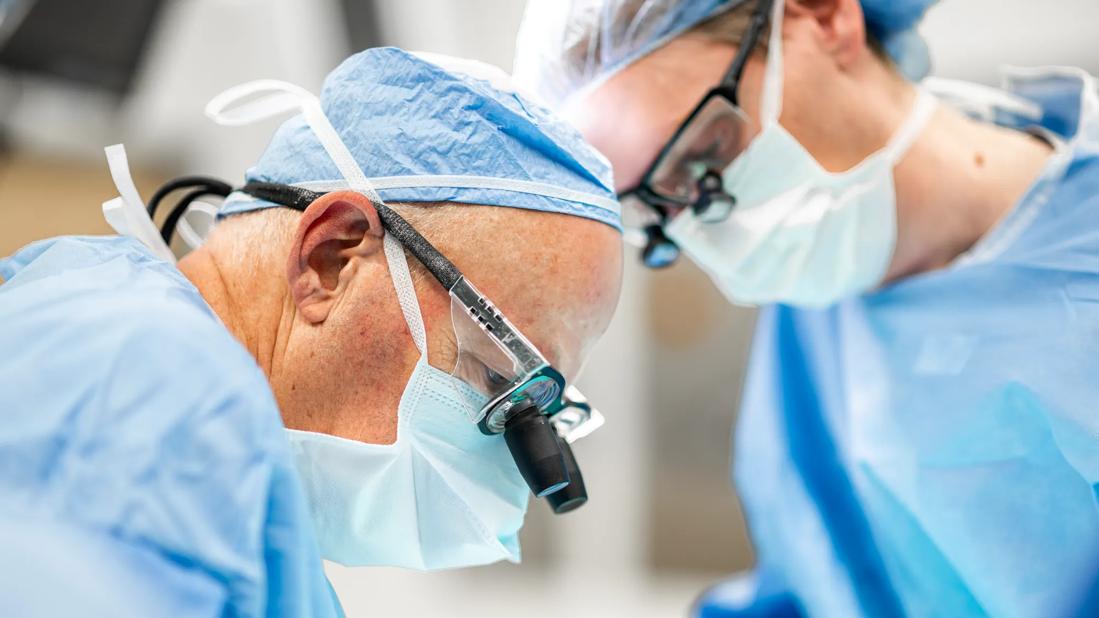A significant number of patients initially referred for unilateral thyroid lobectomy end up needing complete thyroidectomy

The overall risk of needing a total thyroidectomy was found to be 19.4% for patients undergoing lobectomy for indeterminate and high-risk thyroid nodules in a recent Cleveland Clinic study led by Allan Siperstein, MD, Chairman of the Department of Endocrine Surgery. The study also found that 21% and 26.5% of patients originally referred for lobectomy had to be upgraded to total thyroidectomy during or immediately after surgery, respectively. These latest findings shed new light on the clinical reality of patients deemed suitable for unilateral thyroid lobectomy.
Advertisement
Cleveland Clinic is a non-profit academic medical center. Advertising on our site helps support our mission. We do not endorse non-Cleveland Clinic products or services. Policy
“The whole point of this research is realizing that more patients, based on their evaluation in the clinic, should be directed toward a total thyroidectomy to lessen the number of patients that need to return for a second operation,” says Dr. Siperstein.
American Thyroid Association (ATA) guidelines are used in pre-operative evaluation of patients with thyroid cancer and suggest a risk-directed approach in determining the extent of surgery needed for thyroid cancer. According to ATA guidelines, total thyroidectomy and radioactive iodine treatment are recommended for high-risk tumors measuring more than 4 cm or those lesions that exhibit adverse pathology. Lobectomy is usually considered suitable for smaller intra-thyroidal tumors with no added risk factors.
“It has become recognized that we can be less aggressive with surgery and, if the nodule is appropriate, the guidelines recommend removing just half of the thyroid” says Dr. Siperstein.
However, he also notes that a significant number of patients with indeterminate nodules fall in the gray zone, because their thyroid cells may not clearly look benign or cancerous on fine needle biopsy.
“This is why we are left in this conundrum,” he says. “The ultrasound gives us a hint of higher or lower probability [of cancer], but unfortunately it is not definitive. Therefore, thyroid nodules need to be worked up by specialists who are very experienced in all of these subtleties.” Patient preferences and disease-specific characteristics should be taken into consideration when making the final recommendation in patients with indeterminate nodules, adds Dr. Siperstein.
Advertisement
The purpose of the current study was to gather data that will aid decision making in patients with indeterminate nodules and clarify the three settings in which the decision about the extent of surgery is being made — the pre-operative setting, the surgery itself and the post-operative setting.
“The ultimate goal was to collect data that would allow for a better discussion and shared decision making to take place between the clinician and the patient in terms of what’s best for the individual patient,” says Dr. Siperstein.
The retrospective study included 700 adult patients with thyroid nodules treated at the Cleveland Clinic Endocrinology & Metabolism Institute over the course of four years (March 2015 – February 2018). Patients underwent either hemi-thyroidectomy (lobectomy with isthmusectomy) or total thyroidectomy; in cases where metastatic disease was confirmed, therapeutic central neck dissection was performed. ATA guidelines were applied in the pre-operative classification of patients.
Independent indications for total thyroidectomy were found for 68.8% (205/298) of indeterminate nodules, while the remainder (32.3%) were considered candidates for lobectomy. The risk of ultimately needing a total thyroidectomy was 19.4% (18/93) in lobectomy-eligible patients — in 4.3% (4/93) of patients the risk was due to intra-operative findings and in 15.7% (14/89) of patients this risk was due to final pathology. Twenty-one percent of patients undergoing lobectomy were upgraded to a total thyroidectomy intra-operatively and 26.5% were upgraded post-operatively.
Advertisement
This is the first study to quantify the risk of patients needing total thyroidectomy in all three clinical settings, notes Dr. Siperstein.
“For about one-fifth the patients who have passed the filter in the office — of being able to just have one lobe out — that decision was altered in the operating room,” he says. The proportion of patients with indeterminate nodules needing a second operation (total thyroidectomy) was 15.7%, as opposed to 26.5% of those with high-risk nodules. “Again, this peppers my discussion with the patients,” he adds. “Some patients will say to just take it all out the first time, while others will say — I’ll take the 25% chance that I’ll need to go back.”
Another surprising finding of the study was the high number of cancers arising from nodules on the other lobe (i.e., the lobe without the primary lesion of interest), pointing to a need for a thorough assessment of both lobes.
“We found that if you have a nodule on the other side, and it is bigger than a centimeter, it has a 50% chance of being a second cancer,” says Dr. Siperstein. “That’s one of the eye-opening numbers that came out of this study that quickly alters the discussion with the patient.”
Advertisement
Advertisement

Large retrospective study suggests DOACs are safe, effective alternative to low-molecular-weight heparin in complex patient population

Care paths and research initiatives aim to answer unmet clinical needs

Study shows high rate of hematologic responses, low rate of disease progression

Bispecific antibody bridging therapy deepens durability of BCMA CAR T-cell therapy without overlapping toxicities in patients with relapsed/refractory multiple myeloma

Phase 2 study brings pivotal advances in treatment efficacy and safety for the most challenging-to-treat population

Patient with quadruple refractory multiple myeloma achieves complete response with cell therapy

Distinct baseline immune profiles can predict response and resistance to different types of CAR-T cells.

National Blood Clot Alliance collaborates with faith-based organizations on first-of-its-kind church bus tour